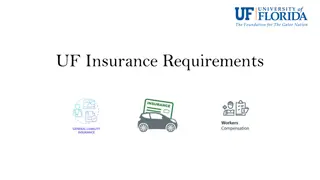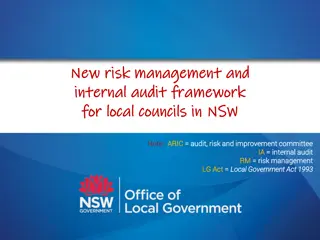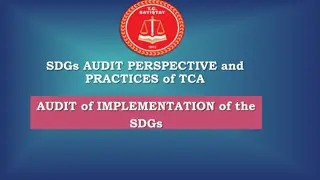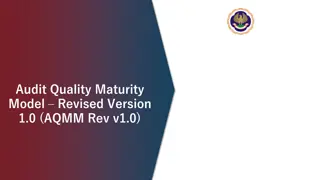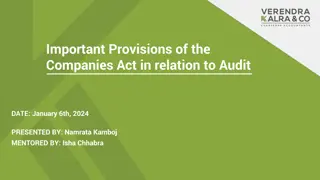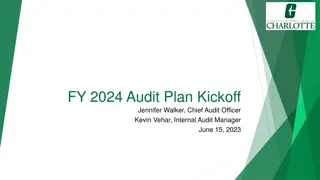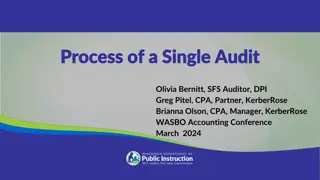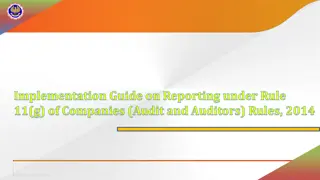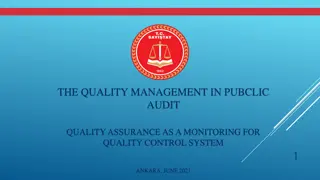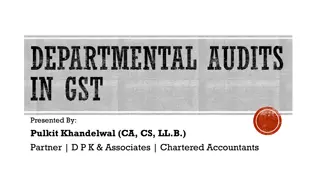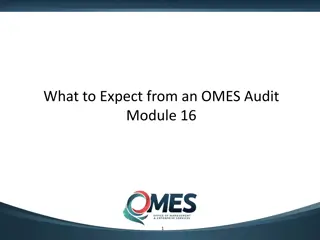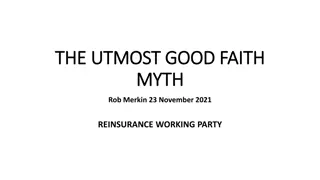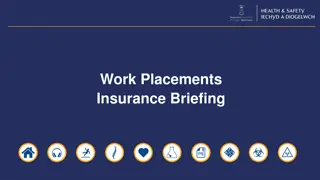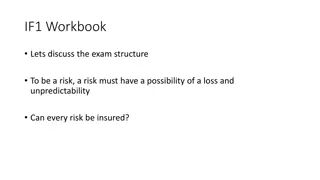Audit of Insurance Companies: Overview and Key Topics
Explore the essential aspects of auditing insurance companies, covering relevant topics such as corporate governance guidelines, appointment of auditors, rights and duties of branch auditors, internal control systems, and reporting requirements. Gain insights into the legislative framework, audit procedures, premium verification, investment valuation, and more, presented by Dr. Kaynat Tawar from Vikram University, Ujjain.
Download Presentation

Please find below an Image/Link to download the presentation.
The content on the website is provided AS IS for your information and personal use only. It may not be sold, licensed, or shared on other websites without obtaining consent from the author. Download presentation by click this link. If you encounter any issues during the download, it is possible that the publisher has removed the file from their server.
E N D
Presentation Transcript
1 SCHOOL OF STUDIES IN COMMERCE SCHOOL OF STUDIES IN COMMERCE VIKRAM UNIVERSITY, UJJAIN (M.P.) VIKRAM UNIVERSITY, UJJAIN (M.P.) DR. KAYNAT TAWAR
2 AUDIT OF INSURANCE AUDIT OF INSURANCE COMPANIES COMPANIES LECTURE BY : LECTURE BY : DR . KAYNAT TAWAR DR . KAYNAT TAWAR DR. KAYNAT TAWAR
RELEVANT TOPICS ON AUDIT OF INSURANCE COMPANIES RELEVANT TOPICS ON AUDIT OF INSURANCE COMPANIES FOR FOR 3 B.COM (HONS.) B.B.A. (HONS.) M.COM. DR. KAYNAT TAWAR
TOPICS TOPICS 4 INTRODUCTION LEGISLATION RELATING TO INSURANCE COMPANIES GUIDELINES FOR CORPORATE GOVERNANCE FOR INSURERS IN INDIA AUDIT COMMITTEE (MANDATORY) APPOINTMENT OF STATUTORY AUDITORS BY INSURERS THE ELIGIBILITY, QUALIFICATIONS AND OTHER REQUIREMENTS OF THE AUDITORS ROTATION OF JOINT AUDITORS AUDIT OF ACCOUNTS DR. KAYNAT TAWAR
5 RIGHTS AND DUTIES OF BRANCH AUDITORS AUDIT PROCEDURE PREMIUM VERIFICATION OF PREMIUM CLAIMS VERIFICATION OF CLAIMS COMMISSION VERIFICATION OF COMMISION OPERATING EXPENSES RELATED TO INSURANCE BUSINESS INVESTMENTS VALUATION OF INVESTMENT DR. KAYNAT TAWAR
6 CASH AND BANK BALANCES OUTSTANDING PREMIUM AND AGENT S BALANCE INTERNAL CONTROL SYSTEM OF AN INSURANCE COMPANY OBJECTIVE OF INTERNAL CONTROL SYSTEM COMPONENTS OF INTERNAL CONTROL SYSTEM APPLICABILITY OF ACCOUNTING STANDARDS BOOKS AND RESGISTERS TO BE MAINTAINED SUBMISSION OF REPORTS AND RETURNS AUDIT REPORT DR. KAYNAT TAWAR
7 THE REPORT OF THE AUDITORS ON THE FINANCIAL STATEMENTS THE AUDITORS SHALL EXPRESS THEIR OPINION ON THE AUDITORS SHALL FURTHER CERTIFY THAT A CERIFICATE SIGNED BY THE AUDITORS MUST CERTIFY THAT IMPORTANT POINTS IN REGARD TO AUDIT REPORT OF INSURANCE COMPANIES DR. KAYNAT TAWAR
INTRODUCTION 8 According to section 2 of insurance act 1938, a Indian insurance company means any insurer being a company. Which is formed and registered under the companies act, 2013. In which the aggregate holdings of equity shares by a foreign company, either by itself or through its subsidiary companies or its nominees, do not exceed twenty-six per cent. Paid up equity capital of such Indian insurance company. Whose sole purpose is to carry on life insurance business or general insurance business or re- insurance business. DR. KAYNAT TAWAR
LEGISLATION RELATING TO INSURANCE COMPANIES 9 Following acts and rules certain important statutory provisions relevant to the audit of life insurance companies- The insurance act 1938. The insurance rules 1939. The income tax act 1961. The companies act 2013. The life insurance corporation act 1956. DR. KAYNAT TAWAR
10 Following acts and rules contain important statutory provisions relevant to the audit of general insurance companies- The insurance act 1938. The insurance rules 1939. The income tax act 1961. The companies act 2013. The income tax rules 1962. Employees state insurance act 1948. DR. KAYNAT TAWAR
GUIDELINES FOR CORPORATE GOVERNANCE FOR INSURERS IN INDIA 11 IRDAI issued guidelines on corporate governance for insurance companies on 5th august, 2009. some of the mandatory committee to be formed are: Audit committee. Investment committee. Risk management committee. Policyholder protection committee. Nomination and remuneration committee. Corporate social responsibility committee. With profit committee. DR. KAYNAT TAWAR
AUDIT COMMITTEE (MANDATORY) 12 Every insurer shall constitute an audit committee as per section 177 of the companies act, 2013. The committee should oversee the financial statements, financial reporting, statement of cash flow and disclosure processes both on an annual and quarterly basis. The chairperson of the audit committee should be an independent director of the board with an auditing/finance/audit experience and may be a chartered accountant or a person with a strong financial analysis background. The association of the CEO in the audit committee requires eliciting any specific information concerning audit findings. As required under section 177 of the companies act, 2013, the audit committee shall comprise of a minimum of three directors, majority of whom shall be independent directors. The audit committee will oversee the efficient functioning of the internal audit department and review its reports. The committee will additionally monitor the progress made in rectification of irregularities and changes in processes wherever deficiencies have come to notice. DR. KAYNAT TAWAR
13 The audit committee shall have the oversight on the procedures and processes established to look after the issues relating to maintenance of books of account, administration procedures, transactions and other matters having a bearing on the financial position of the insurer, whether raised by the auditors or any other person. The audit committee shall discuss with statutory auditors before the audit commences, about the nature and scope of audit as well as have post- audit discussions to address areas of concern DR. KAYNAT TAWAR
APPOINTMENT OF STATUTORY AUDITORS BY INSURERS 14 The provisions of the companies act would apply for the appointment of an auditor. The auditor of an insurance company is appointed at the annual general meeting of the company and the approval of the authority is required before the appointment is made. With the latest amendment of the insurance act, 1938 and the companies act, 2013, authority (IRDAI) has issued the revised guidelines as under: Insurers shall comply with the provisions relating to appointment of auditors as contained in the companies act, 2013. additionally, insurers shall also comply with the provisions contained in these guidelines. On recommendation of the audit committee, the board shall appoint the statutory auditors, subject to the shareholders approval at general meeting of an Indian insurance company. The remuneration of the auditors shall also be approved by the shareholders in the general meeting. DR. KAYNAT TAWAR
THE ELIGIBILITY, QUALIFICATIONS AND OTHER REQUIREMENTS OF THE AUDITORS 15 The auditor of an insurer shall be a firm, including a limited liability firm, constituted under the LLP Act, 2008. The firm should have been established and in continuous practice for at least 15 years. The auditor should have: a) A minimum of 5 full time partners, of whom, i ) At least 2 should have been in full time practice as partners exclusively associated with the firm of a continuous period of minimum of 10 years, and ii) One partner in full time practice with the firm as a partner for a minimum period of 1 year, and DR. KAYNAT TAWAR
16 iii) One partner in full time practice with the firm as a partner for a minimum period of 1 year, and iv) Out of the total partners of the firm, at least two should be FCA and be in practice for a minimum period of 5 years as FCA. Or (alternatively), A minimum of 7 chartered accountants, i) Of which not less than 2 are partners in full time practice exclusively associated with the firm for a continuous period of a minimum of 10 years, and ii) At least 3 other chartered accountants in continuous association with the audit firm as partner or employee for a minimum period of 5 years, and DR. KAYNAT TAWAR
17 iii) At least 2 character accountants should be FCA and be in practice for a minimum period of 5 years as FCA. At least one partner or employee of the audit firm should possess the DISA/ certified information system auditor (CISA)*or equivalent qualification as may be recognized by the IRDAI from time to time and such partner or employee must be involved in the audit of the insurer. The audit firm should have a minimum experience of 5 years in audit of entities in the financial sector. At least one of the joint statutory auditors of an insurer must have experience in insurance company audits of at least two years. *INFORMATION SYSTEM OF AUDIT AND CONTROL ASSOCIATION(ISACA) DR. KAYNAT TAWAR
18 Insurers are also advised to file a return on an annual basis as per the enclosed (Format A3) giving details of chartered accountant firms engaged in various capacities like statutory auditors, internal auditors, concurrent auditors, tax auditors etc. If it comes to the notice of the authority that the appointment of auditors by insurers is not in line with these guidelines, the appointment can be cancelled and it shall be open for the authority to consider such further action as may be deemed necessary in this regard. An insurer shall not remove its statutory auditor without the prior approval of the authority. The maximum number of statutory audits of insurers that can be accepted by an audit firm at a time is as follows: An audit firm shall be entitled to carry out statutory audit of not more than three insurers (life/ non life/health/reinsurer) at a time. DR. KAYNAT TAWAR
ROTATION OF JOINT AUDITORS 19 Each insurer shall have a minimum of two auditors as joint auditors. An audit firm which completes the tenure of five years at the first instance in respect of an insurer may be reappointment as statutory auditors of that insurer for another term of five years. Thus, an audit firm may be appointment as statutory auditors by an insurer for a continuous period of up to ten years. DR. KAYNAT TAWAR
AUDIT OF ACCOUNTS 20 Under section 12 of the insurance act, 1938, the financial statements of every insurer are required to be audited annually by an auditor. IRDA act, 1999, every insurer, in respect of insurance business transacted by him and in respect of his shareholders funds should prepare , a balance sheet, a profit and loss account, a separate account of receipts and payments and a revenue account in accordance with the regulations made by the IRDA at the end of each financial year. DR. KAYNAT TAWAR
RIGHTS AND DUTIES OF BRANCH AUDITORS 21 The branch auditors is appointed to conduct the audit of the divisions have the same rights and obligations under the statute as those of the, statutory auditors to whom they are expected to submit their report. DR. KAYNAT TAWAR
AUDIT PROCEDURE 22 Relating to profit and loss account. Relating to balance sheet. DR. KAYNAT TAWAR
PREMIUM 23 Insurance premium is collected upon issuing policies. It is the consideration for bearing the risk by the insurance company. The premium collections are credited to a separate bank account and no withdrawals are normally permitted from that account for meeting the general expenditure. As per the policy of the insurance company, the collections are transferred to the regional office or head office. No risk shall be assumed by the insurer without receipt of premium according to section 64VB of the insurance act, 1938 DR. KAYNAT TAWAR
VERIFICATION OF PREMIUM 24 Verification of premium is of utmost importance to an auditor. The auditor should apply the following procedures: Before commencing verification of premium income, the auditor should look into the internal controls and compliance which are laid down for collection and recording of the premium. Cover notes should be serially numbered. The auditor should check whether premium registers have been maintained chronologically, giving full particulars including service tax charged as per acceptance advice on a day to day basis. The auditor should verify whether the figure of premium mentioned in the register tally with those in general ledger. The auditor should verify whether installments falling due on or before the balance sheet date, whether received or not, have been accounted for as premium income as for the year under audit. DR. KAYNAT TAWAR
CLAIMS 25 Claims under policies comprise the claims paid for losses incurred, and those estimated or anticipated claims pending settlements under the policies. Settlement cost of claims includes surveyor fee, legal expenses etc. the claim account is debited with all the payments including repair charges, fire fighting expenses, policies report fees. Survey fees, amount decreed by the courts, travel expenses, photograph charges etc. DR. KAYNAT TAWAR
VERIFICATION OF CLAIMS 26 The auditor should obtain from the divisions / branches, information for each class of business. The auditor should determine the total number of documents to be checked giving due importance to claim provisions of higher value. After that auditor should look after the following views - Check whether provision has been made for all unsettled claims. Check whether provision has been made for only such claims for which the company is legally liable. Check whether provision made is normally not in excess of the amount insured. To check in case of co-insurance arrangements, the company has made provisions only in respect of its own share of anticipated liability. To check claimed paid should be duly sanctioned by the authority concerned. DR. KAYNAT TAWAR
COMMISSION 27 An insurance business is solicited by insurance agents. The remuneration of an agent is paid by way of commission which is calculated by applying a percentage to the premium collected by him. Commission is payable to the agents for the business procured through the and is debited to commission on direct business account. DR. KAYNAT TAWAR
VERIFICATION OF COMMISION 28 The auditor can do the verification of commission in the following way Voucher disbursement entries with reference to the disbursement vouchers with copies of commission bills and commission statement. Check whether the vouchers are authorized by the officers in charge as per rules and income tax is deducted at source, as applicable. To check correctness of amounts of commission allowed. To check whether commission outgo for the period under audit been duly accounted or not. DR. KAYNAT TAWAR
OPERATING EXPENSES RELATED TO INSURANCE BUSINESS 29 All the administrative expenses in an insurance company are broadly classified under 13 heads as mentioned in schedule IV. The auditor should check whether the required are as per insurance act. Expenses in excess of Rs 5 Lakhs or 1% of net premium, whether is higher, should be shown separately; and Expenses not directly relating to insurance business should be shown separately , for example, expenses relating to investment department, bank charges etc. DR. KAYNAT TAWAR
INVESTMENTS 30 The auditor should keep in mind the following provisions of the insurance act, 1938 while examining the investments of an insurance company. Provisions related to investments. A) an insurance company can only invest in approved securities. However, it can invest otherwise than in approved securities if the following conditions are satisfied. Such investments should not exceed 25% of the total investments; and Such investments are made with the consent of board of directors. B) an insurer should not invest in shares or debentures of insurance or investment company in excess of least of the following: 10% of its own total assets; 2% of the investee s subscribed share capital or debentures. C) an insurer company should not invest in shares or debentures of a company other than insurance or investment company in excess of least of the following 10% of its own total assets; 10% of investee s subscribed share capital or debentures. D) an insurance company cannot invest in shares and debentures of a private company. E) the insurance companies cannot invest the funds of its policy holders outside India. DR. KAYNAT TAWAR
VALUATION OF INVESTMENT 31 AS 13 i.e. According for Investments , do not apply to insurance companies. The salient features of valuation guidelines laid down for insurance companies are discussed as follows: 1. Real Estate Investment Property : Such investments should be valued at historical cost less accumulated depreciation and impairment loss. 2. Debt Securities : Debt securities including government securities and redeemable preference shares are required to be considered to be considered as held till maturity securities and shall be measured at historical cost. 3. Equity Securities and Derivate Instruments Traded in Active Markets : The equity securities and derivative instruments that are listed are required to be measured at the fair value at the balance sheet date. DR. KAYNAT TAWAR
CASH AND BANK BALANCES 32 The auditor should apply the following audit procedures for verification of claims : The auditor should check whether late collections of cash and cheques on the last working day of the financial year, which could not be deposited into bank account on the same day, have been identified and booked as cash in hand and cheques in hand account, respectively. The auditor may apply test check on the bank transactions. The auditor should also check bank reconciliation statement. The auditor should obtain confirmation of bank balances for all operative and inoperative accounts. The auditor should physically verify term deposit receipts issued by bankers. The auditor should verify the deposits and withdrawals transactions at random and check whether the account is operated by authorized persons only. In case of funds, in transit, he should verify that the same are properly reflected as part of bank balance. DR. KAYNAT TAWAR
OUTSTANDING PREMIUM AND AGENTS BALANCE 33 The audit procedures, which may be followed with regards to agent s balance, are as follows: A) verify whether agent s balances and outstanding balances in outstanding premium account have been listed, analyzed and reconciled for the purposes of audit. B) verify whether recoveries of large outstanding have been made in post audit period. C) verify whether there is any old outstanding debit or credit balances as at the year end which required adjustment. A written explanation may ne obtained from the management is to their nature. D) verify that agent s balances do not include employees balance and balances of other insurance companies. E) verify that no credit of commission is given to agents for businesses directly procured by it. DR. KAYNAT TAWAR
INTERNAL CONTROL SYSTEM OF AN INSURANCE COMPANY 34 * The internal control system for an insurance company is designed with the intention to create an appropriate framework for both insurance undertakings and supervisory authorities. * The internal control system of an insurance company address the following major requirement : Governance structure. Board of directors. CEO. Key management functions. Role of appointment actuaries. External audit appointment of statutory auditors. Disclosures. Relationship with stakeholders. Interaction with the supervisor. Whistle blower policy. DR. KAYNAT TAWAR
OBJECTIVE OF INTERNAL CONTROL SYSTEM 35 Compliance with the law. Structure, responsibility and functions. Sound and judicious principles. DR. KAYNAT TAWAR
COMPONENTS OF INTERNAL CONTROL SYSTEM 36 Control structure. Risk assessment. Control procedure. Information and communication. Monitoring. DR. KAYNAT TAWAR
APPLICABILITY OF ACCOUNTING STANDARDS 37 AS-3 (Cash Flow Basis). AS-4 (Contingencies and events occurring after the balance sheet date). AS-9 (Revenue Recognition). DR. KAYNAT TAWAR
BOOKS AND RESGISTERS TO BE MAINTAINED 38 REGISTERS: - Register of policies - Register of claims BOOKS OF ACCOUNT: - Cash book - Subsidiary records - Control register DR. KAYNAT TAWAR
SUBMISSION OF REPORTS AND RETURNS 39 U/S 18 of the insurance act 1938, every insurer is required to furnish to the authority a certified copy of every report on the affairs of the concern. The audited accounts and statements shall be printed and four copies thereof shall be furnished as returns to the authority within 6 months. DR. KAYNAT TAWAR
AUDIT REPORT 40 The matters to be dealt for the preparation of financial statements and audit s report of insurance companies have prescribed by the authority in regulation 3 under schedule C of IRDA. DR. KAYNAT TAWAR
THE REPORT OF THE AUDITORS ON THE FINANCIAL STATEMENTS 41 That they have obtained all the information and explanations. Examination of books of accounts. Audited or unaudited proper returns from branches and other offices. Examination revenue accounts , profit and loss account and balance sheet. The duly certification of actuarial valuation of liabilities. DR. KAYNAT TAWAR
THE AUDITORS SHALL EXPRESS THEIR OPINION ON 42 1 . (i) a true and fair view of balance sheet. (ii) a true and fair view of revenue account. (iii) a true and fair view of profit and loss account (iv) a true and fair view of receipts and payments account. 2. In accordance with the requirement of the insurance act, 1938, the insurance regulatory and development authority act, 1999 and the companies act, 1956, to the extent applicable and in the manner as so required. 3. Investments in accordance with the provisions of the act and the regulations. 4. Appropriate accounting policies and applicable accounting standard. DR. KAYNAT TAWAR
THE AUDITORS SHALL FURTHER CERTIFY THAT 43 Management report properly reviewed. The insurer has complied with all terms and conditions of the registration specified by the authority. DR. KAYNAT TAWAR
A CERIFICATE SIGNED BY THE AUDITORS MUST CERTIFY THAT 44 Verified the cash balances and the securities and life interest. Extension can be done in case of trusts. No part of the assets applied in contravention of the provisions of the insurance act, 1938. DR. KAYNAT TAWAR
IMPORTANT POINTS IN REGARD TO AUDIT REPORT OF INSURANCE COMPANIES 45 Direction of C & AG Tax audit Applicability of CARO, 2003 DR. KAYNAT TAWAR
REFERENCE REFERENCE 46 www.google.com. www. wikipedia.com DR. KAYNAT TAWAR
CONTACT DETAILS CONTACT DETAILS 47 EMAIL :dr.kaynattawar@gmail.com DR. KAYNAT TAWAR
48 THANK YOU DR. KAYNAT TAWAR












